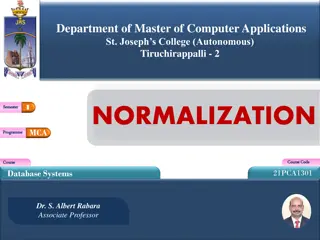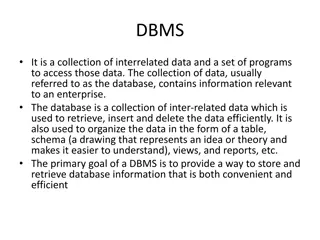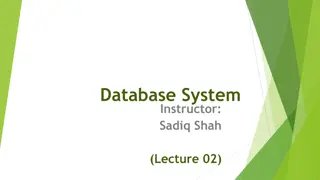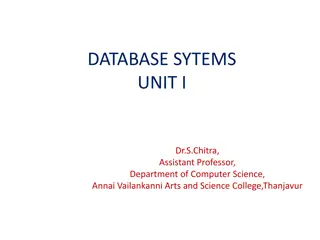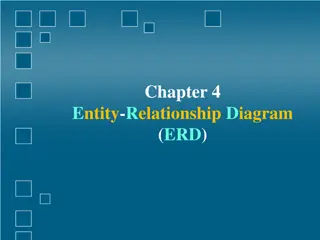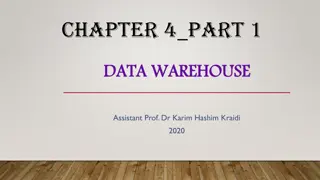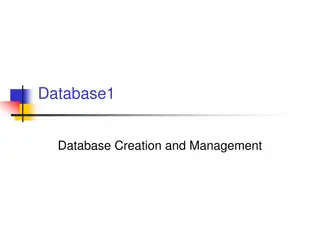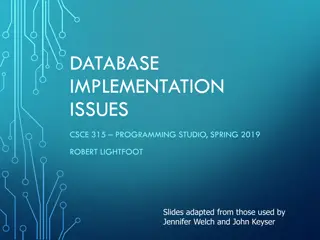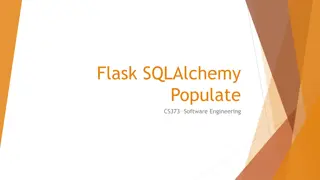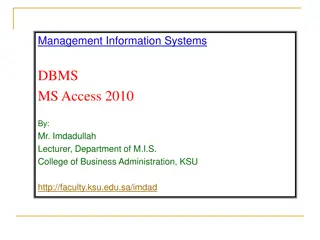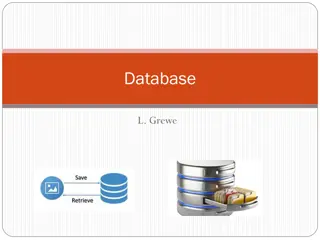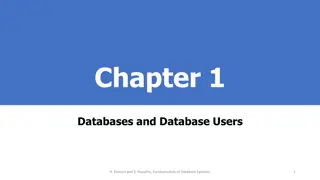Introduction to Database Management Systems
Understanding the fundamentals of Database Management Systems (DBMS), including data models, schema architecture, entity-relationship models, and the role of DBMS in storing, manipulating, and analyzing data efficiently. Explore the significance of database systems in managing information and ensuring data consistency and security.
Download Presentation

Please find below an Image/Link to download the presentation.
The content on the website is provided AS IS for your information and personal use only. It may not be sold, licensed, or shared on other websites without obtaining consent from the author.If you encounter any issues during the download, it is possible that the publisher has removed the file from their server.
You are allowed to download the files provided on this website for personal or commercial use, subject to the condition that they are used lawfully. All files are the property of their respective owners.
The content on the website is provided AS IS for your information and personal use only. It may not be sold, licensed, or shared on other websites without obtaining consent from the author.
E N D
Presentation Transcript
1 CST 204 Database Management Systems MODULE 1 PREPAREDBY NITHA L ROZARIO
2 Syllabus Introduction & Entity Relationship (ER) Model Concept & Overview of Database Management Systems (DBMS). Characteristics of Database system, Database Users, structured, semi-structured and unstructured data. Data Models and Schema - Three Schema architecture. Database Languages, Database architectures and classification. ER model - Basic concepts, entity set & attributes, notations, Relationships and constraints, cardinality, participation, notations, weak entities, relationships of degree 3.
3 Data, Database & DBMS Data Known facts that can be recorded and have implicit meaning Data is nothing but facts and statistics stored or free flowing over a network, generally it's raw and unprocessed Data becomes information when it is processed, turning it into something meaningful.
Database The collection of data A Database is a collection of related data organised in a way that data can be easily accessed, managed and updated. Database-management system (DBMS) is a collection of interrelated data and a set of programs to access those data. General purpose software system that facilitates process of defining, constructing, manipulating, and sharing database
A DBMS is a software that allows creation, definition and manipulation of database, allowing users to store, process and analyse data easily. DBMS also provides protection and security to the databases. It also maintains data consistency in case of multiple users. Here are some examples of popular DBMS used these days: MySql Oracle SQL Server IBM DB2 Amazon SimpleDB (cloud based) etc.
4 The primary goal of a DBMS is to provide a way to store and retrieve database information that is both convenient and efficient.
5 Database systems are designed to manage large bodies of information. Management of data involves both storage of information and mechanisms for manipulation of information. The database system must ensure the safety of the information stored If data are to be shared among several users, the system must avoid possible anomalous results.
6 Database implicit properties Universe of discourse(UoD) or Miniworld Database represent some aspects of real world Changes to miniworld affects database A database is a logically coherent collection of data with some inherent meaning A database is designed, built and populated with data for specific purpose
7 DBMS is a general purpose software system that facilitates process of defining, constructing, manipulating, and sharing database
8 Database System Environment
Characteristics Data stored into Tables Reduced Redundancy Data Consistency Support Multiple user and Concurrent Access Query Language Security DBMS supports transactions
9 Characteristics of the Database Approach 1. Self describing nature of a database system 2. Insulation between programs and data, and data abstraction 3. Support of multiple views of the data
10 Self-Describing Nature of a Database System database system contains not only the database itself but also a complete definition or description of the database structure and constraints. This definition is stored in the DBMS catalog information stored in the catalog is called meta- data and it describes the structure of the primary database.
11 Insulation between Programs and Data, and DataAbstraction The structure of data files is stored in the DBMS catalog separately from the access programs. This property is called program-data independence An operation (also called a function or method) is specified in two parts. Interface The interface (or signature) of an operation includes the operation name and the data types of its arguments (or parameters). Implementation The implementation (or method) of the operation is specified separately and can be changed without affecting the interface.
12 The characteristic that allows program-data independence and program operation independence is called data abstraction.
13 Support of Multiple Views of the Data A database has many users, each user may require a different perspective or view of the database. A view may be a subset of the database or it may contain virtual data that is derived from the database files but is not explicitly stored.
14 Sharing of Data and Multiuser Transaction Processing DBMS must include concurrency control software to ensure that several users trying to update the same data do so in a controlled manner so that the result of the updates is correct DBMS must enforce several transaction properties(ACID) Isolation property Atomicity property
15 Isolation Property ensures that each transaction appears to execute in isolation from other transactions even though hundreds of transactions may be executing concurrently.
16 Atomicity Property ensures that either all the database operations in a transaction are executed or none are. Any mechanical or electrical device is subject to failure, and so is the computer system. In this case we have to ensure that data should be restored to a consistent state. For example an amount of Rs 50 has to be transferred from Account A to Account B. Let the amount has been debited from account A but have not been credited to Account B and in the meantime, some failure occurred. So, it will lead to an inconsistent state. So, we have to adopt a mechanism which ensures that either full transaction should be executed or no transaction should be executed i.e. the fund transfer should be atomic.
17 Concurrent access Problems Many systems allows multiple users to update the data simultaneously. It can also lead the data in an inconsistent state. Suppose a bank account contains a balance of Rs 500 & two customers want to withdraw Rs100 & Rs 50 simultaneously. Both the transaction reads the old balance & withdraw from that old balance which will result in Rs 450 , Rs 400 which is incorrect.
18 Security Problems All the user of database should not be able to access all the data. For example a payroll Personnel needs to access only that part of data which has information about various employees & are not needed to access information about customer accounts.
19 Advantages of DBMS Controlling Redundancy Restricting Unauthorized Access Providing Storage Structures for Efficient Query Processing Providing Backup and Recovery Providing Multiple User Interfaces Representing Complex Relationship among Data Enforcing Integrity Constraints Permitting Inferencing and Actions using Rules
Controlling Redundancy In traditional file processing, every user group maintains its own files for handling its data-processing applications. example,UNIVERSITY database redundancy in storing the same data multiple times leads to several problems. logical update has to be performed multiple times: once for each file where student data is recorded. This leads to duplication of data. storage space is wasted when the same data is stored repeatedly.
Restricting Unauthorized Access When multiple users share a large database, most users will not be authorized to access all information in the database. example, financial data is considered confidential, and only authorized persons are allowed to access such data the type of access operation retrieval or update is also controlled. Users are given account numbers protected by passwords A DBMS should provide a security and authorization subsystem, which the DBA uses to create accounts and to specify account restrictions
Providing Persistent Storage for Program Objects The values of program variables or objects are discarded once a program terminates To store it permanently convert these complex structures into a format suitable for file storage the DBMS software automatically performs any necessary conversions. Hence, a complex object in C++ can be stored permanently in an object-oriented DBMS. Such an object is said to be persistent
Providing Storage Structures and Search Techniques for Efficient Query Processing the DBMS must provide specialized data structures and search techniques to speed up disk search for the desired records. Auxiliary files called indexes are used for this purpose. In order to process the database records they are copied from disk to main memory. DBMS has a buffering or caching module that maintains parts of the database in main memory buffers. The query processing and optimization module of the DBMS is responsible for choosing an efficient query execution plan
Providing Backup and Recovery The backup and recovery subsystem of the DBMS is responsible for recovery the recovery subsystem is responsible to restore the state it was in before the transaction started executing. Also ensure that the transaction is resumed from the point at which it was interrupted
Providing Multiple User Interfaces a DBMS should provide a variety of user interfaces. query languages for casual users programming language interfaces for application programmers forms and command codes for parametric users menu-driven interfaces and natural language interfaces for standalone users.
Representing Complex Relationships among Data A database may include numerous varieties of data that are interrelated in many ways. Enforcing Integrity Constraints integrity constraints involves specifying that a record in one file must be related to records in other files .This is known as a referential integrity constraint. Another type of constraint specifies uniqueness on data item values. This is known as a key or uniqueness constraint.
20 Disadvantages of DBMS Cost of Hardware & Software Cost of Data Conversion Cost of Staff Training Appointing Technical Staff Database Damage
21 DBMS Structure
22 Database Users andAdministrators A primary goal of a database system is to retrieve information from and store new information in the database. People who work with a database can be categorized as database users or database administrators.
Users of Database Depending on the degree of expertise or mode of interaction with DBMS the users of database Database Administrator Application Programmers Sophisticated Users Naive Users
Database Administrator (DBA) Database Administrator (DBA) is a person/team who defines the schema and also controls the 3 levels of database. The DBA will then create a new account id and password for the user if he/she need to access the data base. DBA is also responsible for providing security to the data base and he allows only the authorized users to access/modify the data
DBA also monitors the recovery and back up and provide technical support. The DBA has a DBA account in the DBMS which called a system or superuser account. DBA repairs damage caused due to hardware and/or software failures.
Application Programmer Application Programmer are the back end programmers who writes the code for the application programs. They are the computer professionals. These Programming languages such as Visual Basic, Developer, C, FORTRAN, COBOL etc. programs could be written in
Sophisticated Users Sophisticated users can be engineers, scientists, business analyst, who are familiar with the database. They can develop their own data base applications according to their requirement. They don t write the program code but they interact the data base by writing SQL queries directly through the query processor.
Naive Users Parametric End Users are the unsophisticated who don t have any DBMS knowledge but they frequently use the data base applications in their daily life to get the desired results. For examples, Railway s ticket booking users are naive users. Clerks in any bank is a naive user because they don t have any DBMS knowledge but they still use the database and perform their given task.
29 ACTORS ON THE SCENE The people whose jobs involve the day-to-day use of a large database are called as the actors on the scene. 1. Database Administrators 2. Database Designers 3. End Users 4. System Analyst and Application Programmers(Software engineers)
30 WORKERS BEHIND THE SCENE The people who work to maintain the database system environment but who are not actively interested in the database contents as part of their daily job are called as the workers behind the scene 1. DBMS system designers and implementers 2. Tool developers 3. Operators and maintenance personnel (system administration personnel)
31 Structured, Semi-structured and Unstructured data
32 Structured data Represented in a strict format It has been organized into a formatted repository that is typically a database. It concerns all data which can be stored in database SQL in a table with rows and columns . Example: Relational data
33 Semi-Structured data information that does not reside in a relational database but that have some organizational properties that make it easier to analyze With some process, you can store them in the relation database but Semi-structured exist to ease space. Example: XML data
34 Unstructured data data which is not organized in a predefined manner or does not have a predefined data model thus it is not a good fit for a mainstream relational database there are alternative platforms for storing and managing, used by organizations in a variety of business intelligence and analytics applications. Example: Word, PDF, Text, Medialogs.
36 Data Models a collection of concepts that can be used to describe the structure of a database structure of a database we mean the data types, relationships, and constraints that should hold on the data. Most data models also include a set of basic operations for specifying retrievals and updates on the database.
37 Categories of Data Models High-level or conceptual data models Low-level or physical data models Representational (or implementation) data models
38 High-level or conceptual data models provide concepts that are close to the way many users perceive data use concepts such as entities, attributes, and relationships An entity represents a real-world object or concept An attribute represents some property of interest that further describes an entity, A relationship among two or more entities represents an interaction among the entities
39 Low-level or physical data models Provide concepts that describe the details of how data is stored in the computer. Concepts provided by low-level data models are generally meant for computer specialists, not for typical end users. Describe how data is stored in the computer by representing information formats, record orderings, and access paths. An access path is a structure that makes the search for particular database records efficient. such as record
41 Schemas, Instances, and Database State The description of a database is called the database schema, which is specified during database design and is not expected to change frequently A displayed schema is called a schema diagram. We call each object in the schema a schema construct. The data in database at particular instant or moment of time is called database state or snapshot




